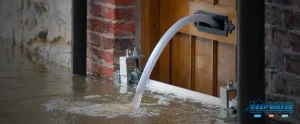What is Clay Soil?
Clay soils contain minerals and a negative charge that can bond water molecules. This soil type also has the largest spore area. These properties allow clay to absorb water, expand in volume, and become saturated when wet.
While clay ground is capable of holding water, only about half of this is shared with plants and crops. Also, if your home foundation is built on clay soil, it loses its ability to hold things together the more it gets wet. This is similar to the result that you’ll get when your feet step on a soggy lawn; you will sink into the mud.
Why Are Wet Clay Soils Dangerous?
Soil will undergo repeated expansion and contraction based on variations in its water content. Clay soil, however, is more reactive than other types, especially when it comes to wet-dry cycles because it contains a large amount of minerals. When it gets wet, soil clay can expose your house to the following risks:
1. The house could sink if the clay soil gets soaked.
Clay soil can become extremely soft as it retains water. Thus, it will be unable to provide adequate support for your home, causing this to sink to the ground where it can settle unevenly.
2. The house could move when you have wet clay soil as the foundation.
Flooding, heavy rains, poor gutter systems, and plumbing leaks can all lead to clay soil under your home getting wet. When this happens, the soil expands, causing it to move up. This upward movement can often lift either the entire home foundation, or a potion of it and lead to uneven floors.
Additionally, uncontrolled house movement can cause problems such as cracks in the foundation, floors, walls, and ceilings, as well as misalignment of window, door, and roof frames.
3. Wet clay soils could lead to the formation of a sinkhole.
Home foundation failure could be caused by a sinkhole that developed underneath. Sinkholes are most common in areas that have clay soil and soluble rock such as limestone, salt and/or carbonate rocks. Groundwater can dissolve and wash away these materials as it moves through the soil. If left untreated, the soil can eventually shrink and dissolve, especially in dry weather, and lead to the formation of underground voids or gaps. Anything found above the soil will consequently settle into the void.
Ways to Minimize Wet Clay Soil Risks
Many home foundation damage is often due to moisture, so all efforts should be focused on how to control or manage this. Also, while it is impossible to remove the clay soil below your foundation, you can work on reducing its impact by considering the following:
1. Install gutters.
To move water away from your home’s perimeter, you can install gutters. At first glance, gutters might be more applicable to your roof than to your foundation, but there is actually a relationship between the two that is often overlooked by many homeowners.
Briefly, gutters can allow rainwater to drain away from the foundation soil depending on how they are designed. If these are installed in a straight downward fashion, water can leach into the soil rapidly, causing saturation.
2. Build retaining walls.
The most effective way to resolve clay soil foundation problems is to build retaining walls. These are especially effective in preventing soil from sliding down sloped ground because they can clearly separate different elevations. They can also redirect water away from the foundation.
Direct drainage is usually installed on these walls to protect the elevated section and to improve water diversion. In general, retaining walls that are anchored with support beams is best, but there are other options depending on the land where your house was built upon.
3. Do landscaping.
A low-cost method to protect your clay soil is to plant shrubs and flowers around your home. A clay soil’s uppermost layers will be protected from rain erosion and wind damage by greenery.The roots of your plants can also strengthen the soil and provide support further below the ground. It’s a simple but effective means of how to compact wet clay soil.
4. Install a push-pier.
Clay soil set beneath the foundation should swell uniformly to reduce the difference between its parts. A push or drilled pier can help in this regard. This is a structural process that uses high-strength steel tubing that is driven through unstable soil and into the ground below. The basic premise is that with more soil moisture, the deeper the drilled pier should be pushed.
5. Apply drip irrigation.
This is a method of watering plants and trees where the amount of water that is absorbed by the soil is reduced. This can apply to the sprinkler system where timers can be used to keep the lawn from getting too wet. In this regard, trees and shrubbery should be planted and managed at least 10 feet away from your home so they can continue absorbing water. while keeping your clay soil foundation dry.
6. Control AC condensation.
Condensation from your air conditioning unit can eventually turn your clay soil damp. Thus, you need to ensure that the condensation line from your unit is designed in such a way that water drains away from the foundation.
7. Slope regrading
Terrain regrading lets gravity work with you so water is drawn away from your home’s base. The method works on sloping the ground away from the foundation by at least one foot, which is a practical way of how to dry out wet clay soil.
Key Takeaway
Clay soil is not the best foundation for any home or building because it places the property at risk, especially when it gets wet. Among other things, wet clay soil can cause your home to move in one direction, and in a worse case scenario, your house could sink or fall to the ground below.
Nevertheless, there are ways to mitigate, if not totally prevent, these dangers from taking place. For one, you can have the terrain regraded so a slope that moves away from your home’s foundation can be created. Similarly, your roof gutter can be installed in a way that it allows rainwater to fall away from the house instead of pouring directly down the clay soil. This will prevent the soil from becoming wet and soggy, and exposing you to water damage, for which you’ll need the services of water damage mitigation experts.
Deep Water Emergency Services & Mitigation can keep your house safe from water damage due to wet clay soil.
Water damage does not always happen after a flood. Sometimes, the damage takes place because your home was built on unstable soil like clay. No need to worry, however, because Deep Water Emergency Services & Mitigation can help you.
Just call us anytime, and our team of water damage mitigation Colorado Springs experts will come over to your place, make the needed inspection on the soil that surrounds your home, and offer you options on how this can be strengthened so water damage can be avoided. As they say, prevention is better than cure, so call us now to ensure your safety.






